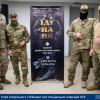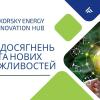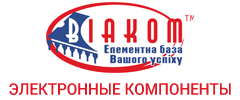Збирач потоків
Deep Brain Stimulation pacemaker on xray.
 | submitted by /u/nixxon94 [link] [comments] |
Зустріч з бійцями Сил спеціальних операцій ЗСУ
КПІшники зустрілися з бійцями Сил спеціальних операцій ЗСУ — військовими, які успішно виконуюють надскладні бойові операції на фронті й в тилу ворога.
This video provides an interesting lesson on how traffic lights are made using logic circuits.
 | submitted by /u/rodrigtti [link] [comments] |
DsPIC33CK adapter board I created in kicad to use this multi phase board.
 | Need to try still if it works [link] [comments] |
John Bardeen (left), Walter Brattain (right), inventors of the BJT. William Shockley (seated) took undeserved credit. All 3 shared the 1956 Nobel Prize in Physics.
 | submitted by /u/1Davide [link] [comments] |
Auction of CrayoNano’s assets extended to 17 March
Енерго-Інноваційний Хаб КПІ: рік досягнень та нових можливостей
Центр декарбонізації енергетики та Енерго-Інноваційний Хаб КПІ ім. Ігоря Сікорського в його складі активно розвиваються, впроваджуючи інноваційні рішення та укріплюючи партнерські зв’язки. За трохи більше ніж рік від створення Хаб уже досягнув низки стратегічних успіхів.
The downside of overdesign, Part 2: A Dunn history

Editor’s Note: This is a two-part series. Part 1 can be found here.
My father, John Edward Dunn, was a Foreman in the New York City Department of Bridges. His shop was in Brooklyn on Kent Avenue adjacent to the Brooklyn Navy Yard. His first assistant at that shop was a man named Connie Rank. Dad’s responsibilities were to oversee the maintenance and repairs of all of the smaller bridges in Brooklyn, Staten Island, and parts of Queens. The Mill Basin Bridge was one of his.
Dad was on call 24/7 in response to any bridge emergencies. At any time of day or night a phone call would come in and he would have to respond. When calls came in at 2 AM or 3 AM or whenever, the whole household would be awakened. Dad would answer the call and I would hear “Yeah. Okay, I’m on my way.” Then I’d hear Dad dialing a call where I’d hear “Connie? Yeah. See you there,” and that would be that. The routine was that familiar. Nothing further needed to be said. He wouldn’t get home again until at least 5:30 PM the following day for having responded to whatever emergency had occurred and then having worked a full day afterward without interruption.
Many of those emergencies were at the Mill Basin Bridge. One of them made the front page of a city newspaper. There was a full page photo of the bridge taken from ground level showing all kinds of emergency vehicles on the scene with all of their lights gleaming against the dark sky. Dad showed me that paper and asked “Do you see that little dot here?” I said “Yes,” and he said, “That little dot is me.” He knew where he had been standing.
Following one accident, perhaps it was the accident above, Dad apparently saved someone’s life. He was honored for that by Mayor Robert F. Wagner. Neither I at the age of twelve nor my sister at nine were ever told the details of the event, but it led to Dad shaking hands with the Mayor at New York City Hall.

John Dunn’s late father, John Edward Dunn, shaking hands with NYC mayor Robert F. Wagner circa 1956 to receive an award for his brave work saving a life as a foreman with the NYC Department of Bridges.
John Dunn is an electronics consultant, and a graduate of The Polytechnic Institute of Brooklyn (BSEE) and of New York University (MSEE).
Related Content
- The downside of overdesign
- Loud noise makers and worker safety
- RF power amplifier safety
- Fractured wires and automotive safety
- The headlights and turn signal design blunder
The post The downside of overdesign, Part 2: A Dunn history appeared first on EDN.
5N+ sells AZUR subsidiary’s GaN IP portfolio to micro-LED specialist ALLOS
NUBURU partners with COEPTIS NexGenAI Affiliates Network
Top 10 Reflow Oven Manufacturers in India
India’s electronics manufacturing sector has witnessed remarkable growth, driving a rising demand for high-quality reflow ovens, which are essential for soldering surface-mount components onto printed circuit boards (PCBs). Several Indian companies have emerged as key players in this industry, offering advanced reflow oven solutions tailored to domestic and international requirements. Below is an overview of the top 10 reflow oven manufacturers in India, highlighting their technological advancements and industry contributions.
- Heller India
Heller India, a subsidiary of Heller Industries, is known for its cutting-edge reflow soldering ovens. Their product range includes convection reflow ovens, voidless/vacuum reflow soldering ovens, and fluxless/formic reflow soldering ovens, as well as curing ovens. These solutions cater to applications such as surface-mount technology (SMT) reflow, semiconductor packaging, consumer electronics assembly, and power device packaging. Heller India’s products emphasize efficiency and sustainability, featuring Industry 4.0 compatibility, low-height top shells, and innovative flux management systems.
- Leaptech Corporation
Headquartered in Mumbai, Leaptech Corporation provides a diverse range of SMT equipment, including high-performance reflow soldering ovens. They are authorized distributors of ITW EAE Vitronics Soltec’s Centurion Reflow Ovens, which offer exceptional reliability and precise thermal performance. The Centurion platform includes forced-convection SMT reflow systems with closed-loop process control, ideal for high-throughput PCB assembly environments. Leaptech also supplies Tangteck reflow ovens, including IR & hot air SMT reflow furnaces, BGA soldering reflow furnaces, and curing furnaces tailored to different production needs.
- EMS Technologies
EMS Technologies, located in Bangalore, specializes in manufacturing reflow ovens and other SMT equipment. Their flagship model, the Konark 1020, is a 10-zone reflow oven designed for complex PCB assemblies. It features a Windows 10-based PC interface, data logging traceability, adjustable blower speed, and PID closed-loop temperature control, ensuring superior precision in soldering operations.
- Mectronics Marketing Services
Mectronics Marketing Services, based in New Delhi, is a leading provider of electronic manufacturing equipment, including reflow soldering systems. Their EPS reflow ovens incorporate patented Horizontal Convection technology, ensuring uniform heating across the entire PCB. The company’s product lineup includes benchtop solder reflow ovens, batch ovens, automatic floor-style systems, hot plates, and vapor phase ovens, catering to various scales of electronics production.
- Sumitron Exports
Operating from New Delhi, Sumitron Exports is a key supplier of high-quality soldering solutions, including reflow ovens. Partnering with renowned international brands, they bring advanced reflow soldering technology to the Indian market, addressing the needs of modern electronics manufacturers.
- Accurex Solutions Pvt. Ltd.
Accurex Solutions Pvt. Ltd. is a leading supplier of SMT equipment, including advanced reflow soldering ovens. Their product range is designed to meet the high-performance demands of modern electronics manufacturing, ensuring precision and reliability.
- SumiLax SMT Technologies Private Limited
Based in New Delhi, SumiLax SMT Technologies offers a wide range of reflow ovens, including models such as the T960 and T980. These ovens provide efficient and reliable soldering solutions, catering to diverse SMT production requirements.
- Hamming Technology Private Limited
Located in Noida, Hamming Technology specializes in manufacturing lead-free reflow ovens. Their products feature advanced PID+SSR control modes and hot air circulation heating technology, ensuring efficient, consistent, and high-quality soldering processes.
- Shenzhen Jaguar Automation Equipment Co., Ltd.
Although headquartered in Shenzhen, China, Shenzhen Jaguar Automation Equipment Co., Ltd. has a prominent presence in the Indian market. Their reflow soldering machines, including models like the A4, are known for their high precision and efficiency in SMT production lines.
- GoldLand Electronic Technology Co., Ltd.
GoldLand Electronic Technology Co., Ltd. is another international player with a strong foothold in India, offering advanced reflow ovens suited for various SMT applications. Their products are recognized for quality and reliability in electronics manufacturing.
These companies play a crucial role in strengthening India’s electronics manufacturing ecosystem by providing innovative reflow oven solutions. Their commitment to technological advancements ensures that Indian manufacturers have access to state-of-the-art equipment, facilitating the production of high-quality electronic products.
The post Top 10 Reflow Oven Manufacturers in India appeared first on ELE Times.
Understanding Soft Soldering: Definition, Process, Working, Uses & Advantages
Soft soldering is a process used to join metal components by melting a filler metal, known as solder, which has a low melting point, typically below 450°C (842°F). The solder forms a bond between the surfaces without melting the base metals. It is widely used in electronics, plumbing, and jewellery making due to its ability to create strong yet flexible joints. Unlike hard soldering or welding, soft soldering does not require extremely high temperatures, making it ideal for delicate workpieces.
How Soft Soldering WorksSoft soldering involves heating the joint area to a temperature sufficient to melt the solder but not the base materials. A soldering iron, torch, or another heat source is used to bring the solder to its melting point. When melted, the solder flows into the joint by capillary action and solidifies as it cools, forming a mechanical and electrical connection. The effectiveness of this process depends on the cleanliness of the surfaces, the proper use of flux, and the choice of solder alloy.
Soft Soldering ProcessThe soft soldering process follows several essential steps to ensure a secure and reliable joint:
- Surface Preparation: Before soldering, the metal surfaces must be cleaned thoroughly to remove any dirt, oxidation, or grease. This can be done using abrasive pads, chemical cleaners, or flux.
- Application of Flux: Flux is a chemical agent that prevents oxidation and helps the solder adhere to the metal surfaces. It is applied to the joint area before heating.
- Heating the Joint: A soldering iron or other heat source is used to heat the metal surfaces to the required temperature. The heat must be sufficient to melt the solder but not damage the components.
- Applying Solder: Once the surfaces are heated, the solder is applied to the joint. It melts and flows into the gap between the metals through capillary action, creating a bond.
- Cooling and Solidification: After the solder has flowed into the joint, the heat source is removed, allowing the solder to cool and solidify. Proper cooling ensures a strong and durable bond.
- Cleaning the Joint: Any residual flux or oxidation by-product should be cleaned off using alcohol or other cleaning solutions to prevent corrosion or electrical issues.
Soft soldering is widely applied across various industries due to its versatility and ease of use. Some of its common applications include:
- Electronics: Soft soldering is extensively used in the electronics industry for assembling circuit boards, connecting wires, and securing components. It ensures reliable electrical conductivity while maintaining component integrity.
- Plumbing: In household plumbing, soft soldering is employed to join copper pipes, creating leak-proof connections. Lead-free solders are used to ensure safe drinking water systems.
- Jewellery Making: Soft soldering allows jewellers to join delicate metal pieces without compromising their structural integrity or aesthetic appeal.
- Automotive Industry: Automotive manufacturers use soft soldering for electrical connections in vehicles, ensuring durability and performance.
- Arts and Crafts: Artists and craftsperson utilize soft soldering for creating decorative metalwork, stained glass, and intricate designs.
Soft soldering offers several benefits, making it a preferred method for many applications:
- Low Operating Temperature: Soft soldering requires lower temperatures compared to brazing or welding, reducing the risk of heat damage to components.
- Ease of Use: The process is simple and does not require specialized training or expensive equipment.
- Cost-Effective: Soft soldering uses affordable materials and tools, making it an economical joining method.
- Good Electrical Conductivity: The soldered joints provide excellent electrical conductivity, making it ideal for electronic circuits.
- Reversibility: If necessary, soldered joints can be easily reworked or repaired by reheating the solder.
- Compatibility with Thin Materials: Soft soldering is suitable for delicate and thin metals that might be damaged by higher-temperature processes.
Despite its advantages, soft soldering has some limitations that must be considered:
- Lower Strength: Soft soldered joints are not as strong as brazed or welded joints, making them unsuitable for high-load applications.
- Limited Temperature Resistance: The low melting point of soft solder means that joints can weaken or fail at high temperatures.
- Flux Residue Issues: If not cleaned properly, residual flux can lead to corrosion or contamination in sensitive applications.
- Potential Toxicity: Some solder materials, particularly those containing lead, can be hazardous to health and the environment, necessitating the use of lead-free alternatives.
Soft soldering remains an essential technique in various industries, offering a balance of affordability, ease of use, and effectiveness. While it has certain limitations, its advantages make it a preferred method for applications requiring electrical conductivity, delicate metalwork, and low-temperature bonding. By understanding the process, applications, and considerations, professionals and hobbyists alike can make the most of soft soldering in their projects.
The post Understanding Soft Soldering: Definition, Process, Working, Uses & Advantages appeared first on ELE Times.
Wireless MCUs deliver richer functionality

STM32WBA6 2.4-GHz wireless MCUs from ST offer increased memory and digital system interfaces for high-end applications in smart home, health, factory, and agriculture. Based on an energy-efficient Arm Cortex-M33 core running up to 100 MHz, the devices provide up to twice the flash and RAM of the previous STM32WBA5 series for application code and data storage.
 Giulia Fagiani
Giulia Fagiani
With up to 2 MB of flash and 512 KB of RAM on-chip, the STM32WBA6 MCUs are able to support more advanced applications. Digital peripherals include high-speed USB, three SPI ports, four I2C ports, three USARTs, and one LPUART. By integrating the processing core, peripherals, and wireless subsystems, the MCUs streamline designs and reduce assembly size.
The STM32WBA6 wireless subsystem supports Bluetooth LE, Zigbee, Thread, and Matter, enabling concurrent communication across multiple protocols. It also enhances performance, with sensitivity increased to -100 dBm for more reliable connectivity up to the maximum specified range.
The STM32WBA6 wireless MCUs are in production and available now, priced from $2.50 each in lots of 10,000 units.
Find more datasheets on products like this one at Datasheets.com, searchable by category, part #, description, manufacturer, and more.
The post Wireless MCUs deliver richer functionality appeared first on EDN.
650-V GaN HEMT resides in TOLL package

Rohm Semiconductor introduced the GNP2070TD-Z, a 650-V enhancement-mode GaN HEMT in a TO-leadless (TOLL) package. With dimensions of 11.68×9.9×2.4 mm, this compact package enhances heat dissipation, supports high current, and enables strong switching performance.

The GNP2070TD-Z integrates second-generation GaN-on-Si technology, achieving an RDS(on) of 70 mΩ and a Qg of 5.2 nC. With a VDS of 650 V and an IDS of 27 A, the transistor is well-suited for power supplies, AC adapters, PV inverters, and energy storage systems.
For this launch, ROHM has outsourced package manufacturing to ATX Semiconductor, with TSMC handling front-end processes and ATX managing back-end processes. ROHM also plans to collaborate with ATX on automotive-grade GaN devices.
The EcoGaN HEMTs will be available starting in March from DigiKey, Mouser, and Farnell.
Find more datasheets on products like this one at Datasheets.com, searchable by category, part #, description, manufacturer, and more.
The post 650-V GaN HEMT resides in TOLL package appeared first on EDN.
Marvell’s 2-nm silicon boosts AI infrastructure

Marvell Technology has demonstrated its first 2-nm silicon IP, enhancing the performance and efficiency of AI and cloud infrastructure. Built on TSMC’s 2-nm process, the working silicon is a key component of Marvell’s platform for developing next-generation custom AI accelerators, CPUs, and switches.

The company’s strategy focuses on developing a comprehensive semiconductor IP portfolio, including electrical and optical SerDes, die-to-die interconnects for 2D and 3D devices, advanced packaging technologies, silicon photonics, custom HBM compute architecture, on-chip SRAM, SoC fabrics, and compute fabric interfaces like PCIe Gen 7.
Additionally, the portfolio includes high-speed 3D I/O for vertically stacking die inside chiplets. This simultaneous bidirectional I/O operates at speeds up to 6.4 Gbps. By shifting from conventional unidirectional I/O to bidirectional I/O, designers can double the bandwidth and/or reduce the number of connections by 50%.
“Our longstanding collaboration with TSMC plays a pivotal role in helping Marvell develop complex silicon solutions with industry-leading performance, transistor density, and efficiency,” said Sandeep Bharathi, chief development officer at Marvell.
Find more datasheets on products like this one at Datasheets.com, searchable by category, part #, description, manufacturer, and more.
The post Marvell’s 2-nm silicon boosts AI infrastructure appeared first on EDN.
Armv9 platform advances AI at the edge

Arm’s edge AI platform features the Cortex-A320 CPU and Ethos-U85 NPU, enabling on-device execution of models exceeding 1 billion parameters. The Armv9 platform enhances efficiency, performance, and security for IoT, while unlocking new edge AI applications through support for both large and small language models.

Built on the Armv9 architecture, the Cortex-A320 delivers 10× higher ML performance and 30% better scalar performance than its predecessor, the Cortex-A35. It also achieves an 8× ML performance gain over the Cortex-M85-based platform launched last year. Additionally, Armv9.2 offers advanced security features like pointer authentication, branch target identification, and memory tagging extension.
The Cortex-A320 pairs with the Ethos-U85 AI accelerator, which supports transformer-based models at the edge and scales from 128 to 2048 MAC units. To streamline edge AI development, Arm’s Kleidi for IoT compute libraries enhance AI an ML performance on Arm-based CPUs with seamless ML framework integration. For example, Kleidi boosts Cortex-A320 performance by up to 70% when running Microsoft’s Tiny Stories dataset on Llama.cpp.
To learn more about the Armv9 edge AI platform, click on the product page links below.
Find more datasheets on products like this one at Datasheets.com, searchable by category, part #, description, manufacturer, and more.
The post Armv9 platform advances AI at the edge appeared first on EDN.
32-bit MCUs offer multiple sensing capabilities

Infineon’s PSOC 4 series microcontrollers now integrate capacitive, inductive, and liquid level sensing in a single device. The PSOC 4000T, powered by a 32-bit, 48-MHz Arm Cortex-M0+ processor, combines CAPSENSE capacitive sensing with Multi-Sense inductive sensing and non-invasive, non-contact liquid sensing.

Infineon says Multi-Sense inductive sensing offers greater noise immunity and durability than existing methods. Its differential, ratio-metric architecture supports new HMI and sensing applications, including touch-over-metal, force touch, and proximity sensing.
The PSOC 4000T’s liquid sensing uses an AI/ML-based algorithm that Infineon says is more cost-effective and accurate than mechanical sensors and standard capacitive solutions. It resists environmental factors like temperature and humidity and detects liquid levels with up to 10-bit resolution. It also rejects foam and residue and operates across varying air gaps between the sensor and container.
The fifth-generation CAPSENSE technology enables hover touch sensing, allowing interaction without direct button contact. Its always-on capability reduces power consumption by 10× while delivering 10× higher signal-to-noise ratio than Infineon’s previous devices.
The PSOC 4000T with CAPSENSE and Multi-Sense is available now. A second device, the PSOC 4100T Plus, offering more memory and I/Os, will gain Multi-Sense support in 2Q 2025.
Find more datasheets on products like this one at Datasheets.com, searchable by category, part #, description, manufacturer, and more.
The post 32-bit MCUs offer multiple sensing capabilities appeared first on EDN.
Новий партнер у сфері науки
У КПІ ім. Ігоря Сікорського — новий партнер у сфері науки: Інститут наукових досліджень з цивільного захисту Національного університету цивільного захисту України (ІНДЦЗ НУЦЗУ).
Luminus launches Generation 2 warm dimming COB LEDs
Професорка ФММ Ольга Вовк отримала премію Президента України
Перший національний форум талановитої молоді, що пройшов у столиці наприкінці січня, зібрав понад 400 учасників – призерів міжнародних і всеукраїнських шкільних олімпіад, молодих науковців, студентів, активістів. У межах заходу молодим ученим за їхні наукові досягнення вручили премії Президента України. Отримала відзнаку і Ольга Вовк – професорка кафедри економічної кібернетики КПІ ім. Ігоря Сікорського. Вона поділилася враженнями від цієї урочистої події.







